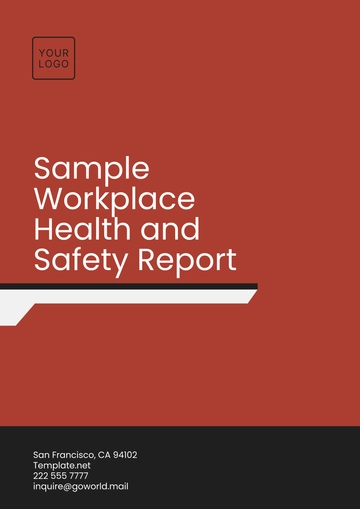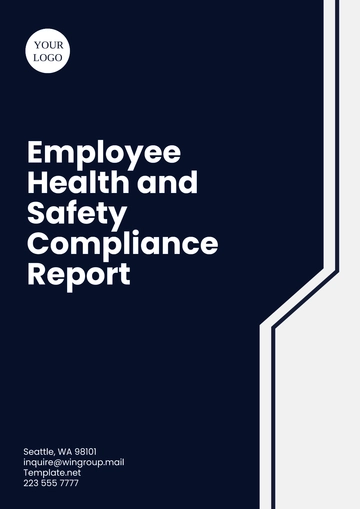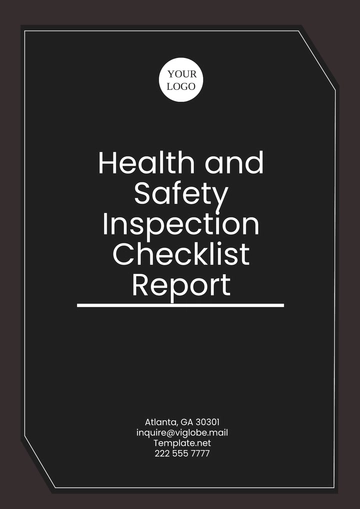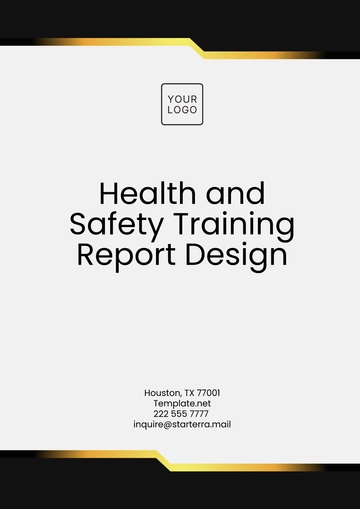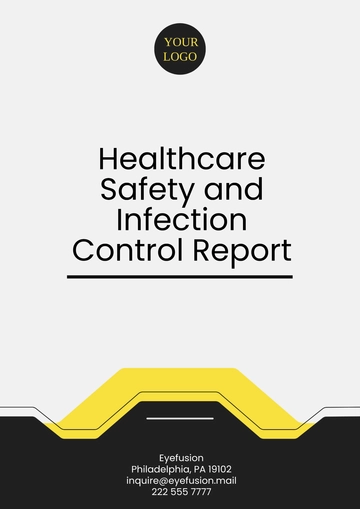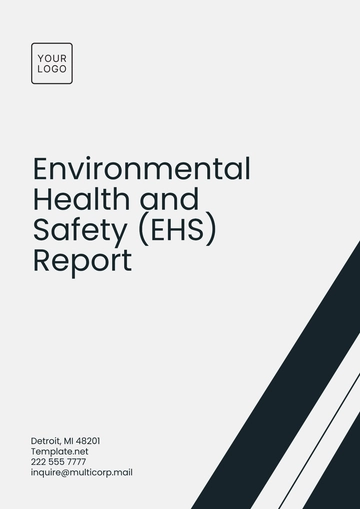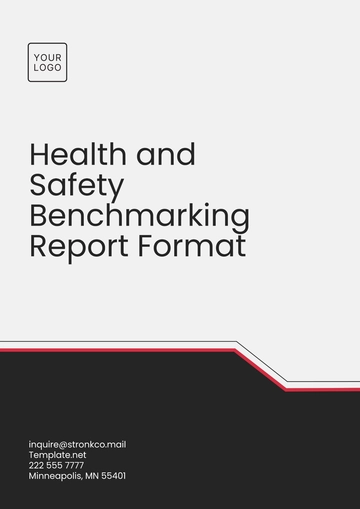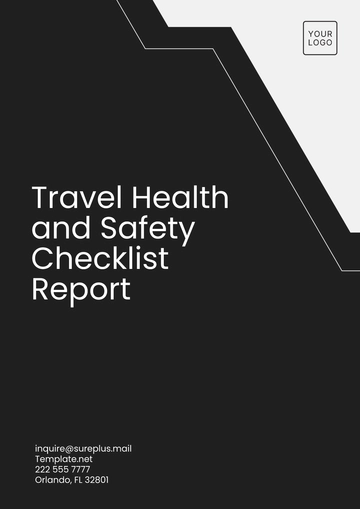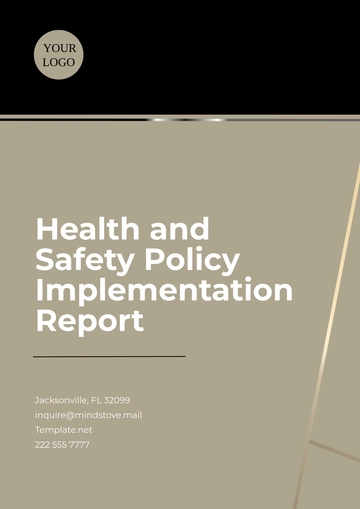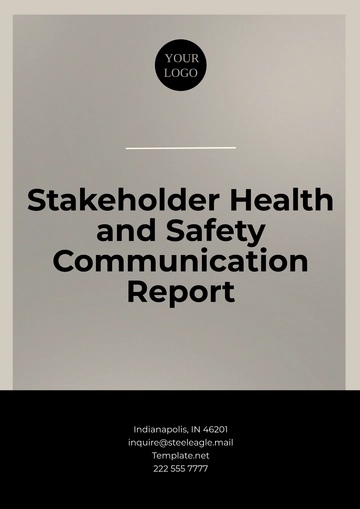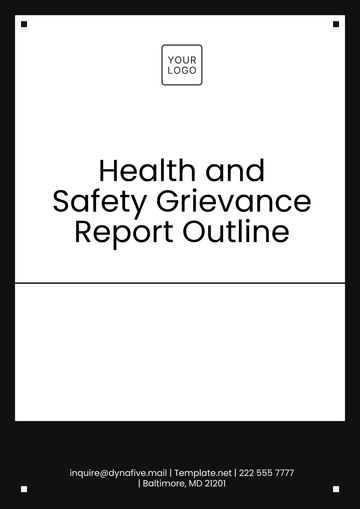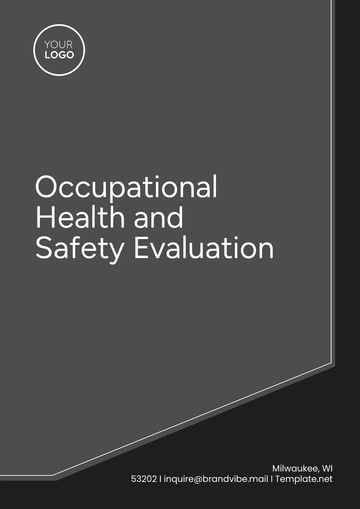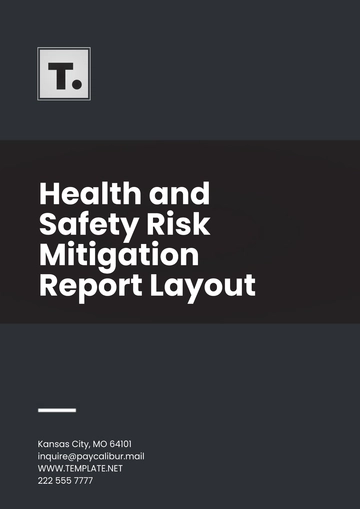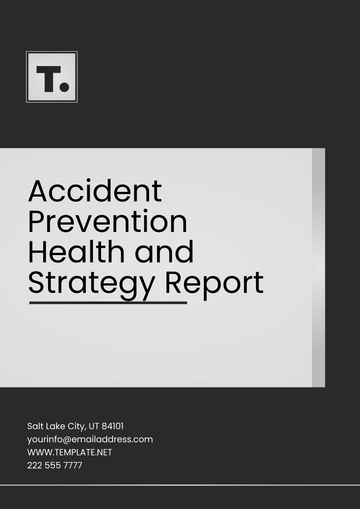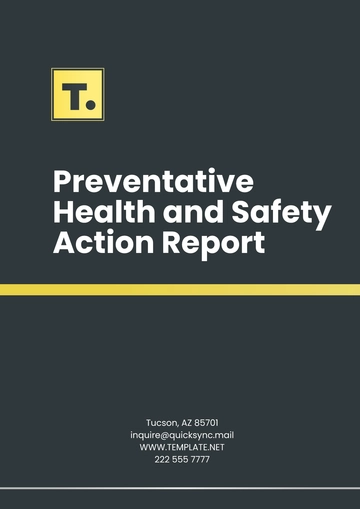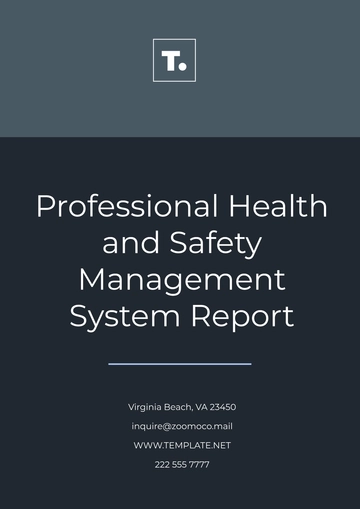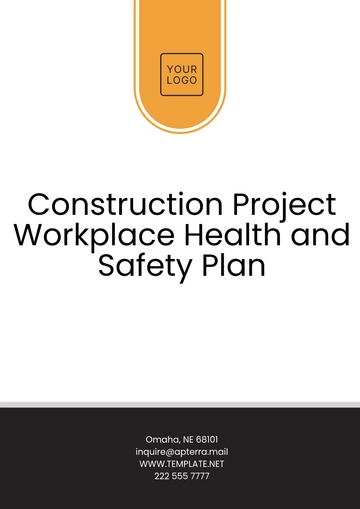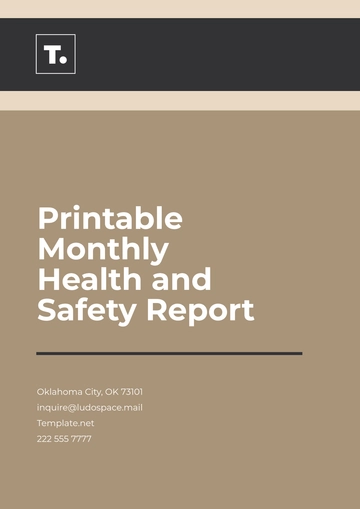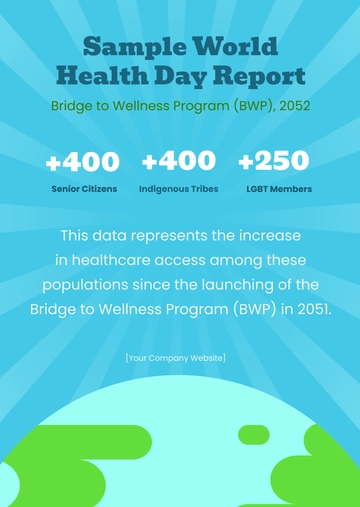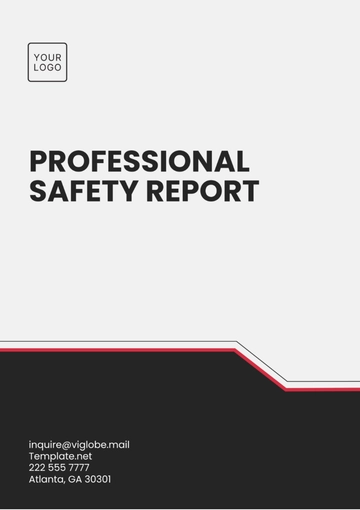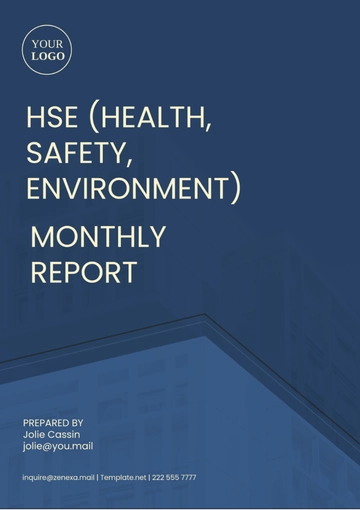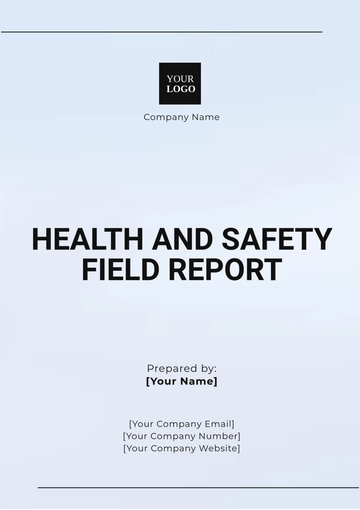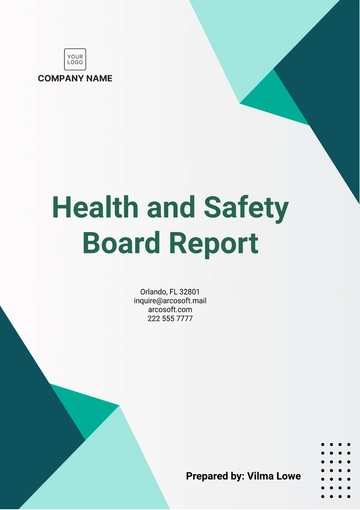Free Workplace Safety Metrics and KPI Report

Introduction
Purpose of the Report
This report aims to provide a comprehensive overview of the current state of workplace safety within our organization. By analyzing various safety metrics and key performance indicators (KPIs), we aim to identify areas for improvement and reinforce successful practices.
Overview of Workplace Safety Standards
Our commitment to workplace safety is grounded in industry standards and regulatory requirements. We consistently strive to exceed these standards through continuous improvement and employee engagement.
Incident Rate Analysis
Total Recordable Incident Rate (TRIR)
2050: 1.8
2051: 1.6
2052: 1.4
Analysis: The steady decline in TRIR over these years can be attributed to the introduction of advanced safety technologies, including AI-based monitoring systems and enhanced employee training programs utilizing virtual reality simulations. The integration of predictive analytics has also played a significant role in proactively identifying and mitigating potential hazards.
Lost Time Incident Rate (LTIR)
2050: 0.8
2051: 0.6
2052: 0.5
Analysis: The reduction in LTIR is a result of improved workplace ergonomics, the use of exoskeletons for physically demanding tasks, and the implementation of comprehensive health and wellness programs. Rapid response and advanced medical facilities on-site have significantly reduced recovery time, further contributing to this positive trend.
Risk Assessment Metrics
Frequency of Risk Assessments
Bi-monthly assessments are conducted across all departments, leveraging advanced data analytics.
Real-time risk monitoring systems provide continuous assessment, significantly reducing response time to potential hazards.
Severity of Identified Risks
Critical Risks: 5% (down from 8% in 2049)
Moderate Risks: 35%
Low Risks: 60%
Analysis and Actions: The decrease in critical risks is largely due to the implementation of sophisticated AI-driven hazard detection systems and employee wearable safety devices. These devices monitor vital signs and environmental conditions, providing immediate alerts to both employees and the safety management team.
Preventive Measures: Regular training sessions utilizing interactive holographic safety scenarios, ensuring employees are well-prepared for a variety of risk situations.
Technology Integration: Continuous upgrading of monitoring and detection systems to stay ahead of emerging risks, particularly those related to cyber-physical systems in the workplace.
Strategy for Further Reduction: Focus on converting moderate risks into low risks through targeted interventions, employee feedback, and enhanced predictive analytics. Additionally, exploring advancements in autonomous safety drones for more effective monitoring of large-scale facilities.
Safety Training and Awareness
Completion Rates of Safety Training Programs
2050: 90%
2051: 93%
2052: 97%
Analysis: The steady increase in training completion rates is due to the integration of immersive training methods, including augmented reality (AR) and virtual reality (VR) simulations, which have made safety training more engaging and effective. We have also implemented flexible training schedules and digital learning platforms to accommodate various learning styles and schedules.
Completion Rates of Safety Training Programs
2050: 90%
2051: 93%
2052: 97%
Analysis: The steady increase in training completion rates is due to the integration of immersive training methods, including augmented reality (AR) and virtual reality (VR) simulations, which have made safety training more engaging and effective. We have also implemented flexible training schedules and digital learning platforms to accommodate various learning styles and schedules.
Employee Safety Awareness Survey Results
Survey Item | 2050 % Positive | 2051 % Positive | 2052 % Positive |
Awareness of Safety Protocols | 80% | 85% | 90% |
Confidence in Handling Emergencies | 75% | 82% | 88% |
Satisfaction with Training Content | 78% | 84% | 91% |
Future Goals: We aim to achieve 95% positive responses in all categories by 2053 by continually updating training content based on technological advancements and employee feedback.
Equipment and Facility Safety
Equipment Maintenance Compliance Rate
2050: 95%
2051: 97%
2052: 99%
Strategy: The near-perfect compliance rate has been achieved through the implementation of IoT-enabled equipment that automatically alerts the maintenance team about upcoming service requirements or potential malfunctions. Additionally, predictive maintenance algorithms have significantly reduced equipment downtime and improved safety.
Facility Safety Audit Results
Facility Area | 2050 Compliance % | 2051 Compliance % | 2052 Compliance % |
Production Area | 92% | 94% | 96% |
Storage and Warehousing | 90% | 93% | 95% |
Office Spaces | 95% | 97% | 98% |
Outdoor Work Areas | 88% | 92% | 94% |
Analysis: Continued improvement in facility safety compliance is attributed to regular audits using advanced scanning technologies and AI-driven analysis. Enhanced employee training in these areas and the adoption of smart safety gear have also contributed to these improvements.
Action Items:
For Production Area and Warehousing: Introduce more advanced robotics to handle high-risk tasks.
For Office Spaces: Continue ergonomic improvements and regular air quality monitoring.
For Outdoor Work Areas: Implement advanced weather monitoring systems and enhanced protective gear for workers.
Long-Term Plan: Continue to integrate cutting-edge safety technologies and maintain a culture of continuous improvement and proactive safety management.
Health and Wellness Programs
Participation in Health Programs
2050: 80%
2051: 85%
2052: 90%
Analysis: The increase in participation rates is attributed to the introduction of personalized health programs, leveraging wearable technology to tailor wellness plans to individual needs. Initiatives such as on-site fitness centers, mental health days, and virtual wellness workshops have also contributed significantly.
Impact on Employee Health and Well-being
Health Indicator | 2050 Improvement | 2051 Improvement | 2052 Improvement |
Stress Reduction | 60% | 65% | 70% |
Physical Fitness Levels | 55% | 62% | 68% |
Overall Job Satisfaction | 70% | 75% | 80% |
Future Initiatives: Plans include introducing AI-powered mental health support tools, expanding telehealth options, and incorporating more holistic wellness practices like yoga and mindfulness meditation into the program offerings.
Emergency Response Preparedness
Efficiency of Emergency Response Drills
Average Evacuation Time (in minutes):
2050: 5.0
2051: 4.5
2052: 4.0
Analysis: The reduction in evacuation time is a result of regular, realistic emergency drills that incorporate virtual reality for scenario training. The integration of smart building technologies that optimize evacuation routes in real-time has also enhanced efficiency.
Employee Readiness and Response Time
Emergency Scenario | 2050 Readiness % | 2051 Readiness % | 2052 Readiness % |
Fire | 88% | 92% | 95% |
Natural Disaster | 85% | 90% | 93% |
Medical Emergency | 90% | 93% | 96% |
Improvement Strategies: To further enhance employee readiness, we plan to introduce more diverse and challenging emergency scenarios in our drills, and leverage augmented reality to provide more immersive training experiences. Additionally, we aim to provide specialized training for designated emergency response teams in each department.
Long-term Goal: Achieve a minimum of 98% readiness for all emergency scenarios by 2054, ensuring that all employees are well-equipped to handle potential emergencies with confidence and efficiency.
Safety Policy Compliance
Compliance Rate with Safety Policies
2050: 96%
2051: 97%
2052: 98%
Analysis: The steady increase in policy compliance can be credited to the introduction of interactive digital platforms for policy dissemination and the implementation of gamified compliance training. Regular feedback sessions and the integration of compliance metrics into performance reviews have also been effective.
Violations and Corrective Actions Taken
Year | Number of Violations | Corrective Actions |
2050 | 25 | Enhanced training, policy revisions |
2051 | 20 | Targeted coaching, process improvements |
2052 | 15 | Automation of compliance checks, continuous training |
Future Focus: Aim to reduce violations to single digits by 2054 through more personalized training approaches and the use of predictive analytics to identify potential areas of non-compliance.
Worker Feedback and Participation
Safety Suggestion Implementation Rate
Suggestions Received: 120 (2052)
Implemented: 60%
Under Consideration: 30%
Engagement Strategy: Encourage more worker feedback by introducing a mobile app for easy submission of safety suggestions and implementing a rewards program for valuable contributions.
Worker Engagement in Safety Committees
Current Participation Rate: 30%
Target for 2053: 40%
Action Plan: To increase engagement, we plan to rotate committee membership to involve more employees and introduce virtual reality-based committee meetings to increase accessibility and interest.
Performance Improvement Plans
Progress on Safety Performance Goals
Goals Set for 2052: 10
Goals Met: 8
Goals in Progress: 2
Analysis: Most goals for the year were met, particularly those related to technological integration and emergency response. The remaining goals are ongoing and involve long-term cultural shifts in safety attitudes.
Plans for Addressing Identified Safety Gaps
Identified Gap | Strategy for Improvement |
Employee Engagement in Safety Practices | Introduce interactive and gamified safety education modules |
Adaptation to New Technologies | Regular upskilling workshops and hands-on training sessions |
Reporting of Near-Misses | Implement an anonymous reporting system to encourage more open communication |
Long-Term Vision: Our aim is to build a culture where safety is ingrained in every aspect of our operations. We plan to continuously evolve our safety strategies to incorporate the latest technological advancements and foster an environment where every employee feels responsible for maintaining a safe workplace.
Conclusion
In reviewing the metrics and KPIs outlined in this report, it's evident that our organization has made significant strides in enhancing workplace safety from 2050 to 2052. Through the integration of advanced technologies, proactive risk assessments, comprehensive training programs, and a strong focus on health and wellness, we have successfully created a safer, more responsive work environment.
The continuous improvement in safety policy compliance, the active participation of our workforce in safety initiatives, and the achievement of most of our safety performance goals are testaments to the effectiveness of our strategies and the commitment of our employees. While we celebrate these successes, we also recognize areas that require further attention and improvement.
Our vision for the future is clear: to foster a culture of safety that is deeply embedded in every aspect of our organization. We will continue to leverage innovative solutions, engage our employees in meaningful ways, and adapt our strategies to meet the evolving demands of our workplace and industry standards.
Through collective effort and unwavering commitment, we are confident in our ability to not only meet but exceed our safety objectives, ensuring a secure and healthy environment for all our employees.
- 100% Customizable, free editor
- Access 1 Million+ Templates, photo’s & graphics
- Download or share as a template
- Click and replace photos, graphics, text, backgrounds
- Resize, crop, AI write & more
- Access advanced editor
Enhance workplace safety with precision using Template.net's Workplace Safety Metrics and KPI Report Template. This editable and customizable tool empowers you to track and analyze key performance indicators effortlessly. With our intuitive Ai Editor Tool, adapt reports to your organization's needs seamlessly, ensuring a safer and more productive work environment.
You may also like
- Sales Report
- Daily Report
- Project Report
- Business Report
- Weekly Report
- Incident Report
- Annual Report
- Report Layout
- Report Design
- Progress Report
- Marketing Report
- Company Report
- Monthly Report
- Audit Report
- Status Report
- School Report
- Reports Hr
- Management Report
- Project Status Report
- Handover Report
- Health And Safety Report
- Restaurant Report
- Construction Report
- Research Report
- Evaluation Report
- Investigation Report
- Employee Report
- Advertising Report
- Weekly Status Report
- Project Management Report
- Finance Report
- Service Report
- Technical Report
- Meeting Report
- Quarterly Report
- Inspection Report
- Medical Report
- Test Report
- Summary Report
- Inventory Report
- Valuation Report
- Operations Report
- Payroll Report
- Training Report
- Job Report
- Case Report
- Performance Report
- Board Report
- Internal Audit Report
- Student Report
- Monthly Management Report
- Small Business Report
- Accident Report
- Call Center Report
- Activity Report
- IT and Software Report
- Internship Report
- Visit Report
- Product Report
- Book Report
- Property Report
- Recruitment Report
- University Report
- Event Report
- SEO Report
- Conference Report
- Narrative Report
- Nursing Home Report
- Preschool Report
- Call Report
- Customer Report
- Employee Incident Report
- Accomplishment Report
- Social Media Report
- Work From Home Report
- Security Report
- Damage Report
- Quality Report
- Internal Report
- Nurse Report
- Real Estate Report
- Hotel Report
- Equipment Report
- Credit Report
- Field Report
- Non Profit Report
- Maintenance Report
- News Report
- Survey Report
- Executive Report
- Law Firm Report
- Advertising Agency Report
- Interior Design Report
- Travel Agency Report
- Stock Report
- Salon Report
- Bug Report
- Workplace Report
- Action Report
- Investor Report
- Cleaning Services Report
- Consulting Report
- Freelancer Report
- Site Visit Report
- Trip Report
- Classroom Observation Report
- Vehicle Report
- Final Report
- Software Report

